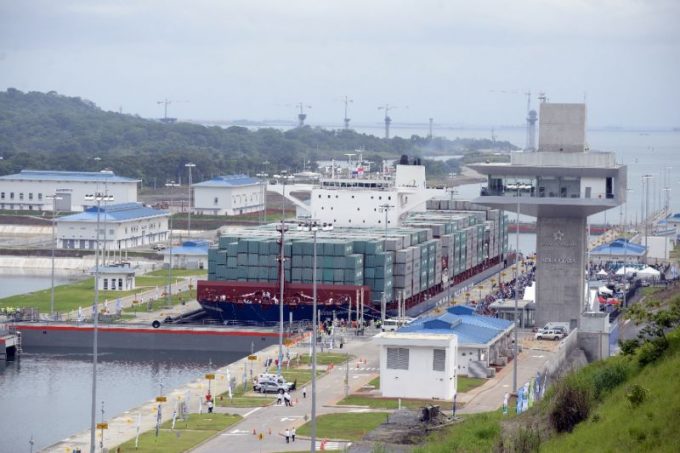Liners add capacity to Asia-ECSA as ocean rates hit 18-month high
With Asia-South America ocean freight rates at an 18-month high of around $4,350 per 40ft, ...

The Panama Canal expansion was formally unveiled at the weekend and has been welcomed by the world’s major container shipping lines.
The first vessel to pass through was the 9,500 teu Cosco Shipping Panama from the Atlantic to the Pacific.
Maersk line said this morning it expected to use the canal more, now that the size of vessel able to pass through its locks had increased from around 5,000teu up to 14,000 teu.
“Maersk Line likely to reroute one or more services with larger vessels through the new Panama Canal locks,” it said.
The carrier said it expected to make more than 400 vessel transits through the canal this year, carrying more than 400,000 containers – equivalent to around 4% of Maersk’s global carryings – at an estimated cost of over $100m.
In comparison, it spent $81m on 313 transits in 2013 and $62m on 268 transits in 2014, when it diverted a number of Asia-US east coast services to the Suez Canal as a way deploying the large vessels being added to its fleet. In Q1 2015, transits jumped once more to 313, due to the congestion on the US west coast.
Chief operating officer Søren Toft said: “As a long-time customer, Maersk Line welcomes the expansion of the Panama Canal. It is a very positive development for trade, Panama and the region, and of course the shipping lines that transit this important corridor every day.”
The Panama Canal accounts for roughly 5% of world sea trade and the expanded waterway is estimated to generate a 3% increase in transiting cargo volumes. Since 60% of the Panama Canal traffic either begins or ends in US ports it will have a direct, notable impact on the trade between Asia and the US east coast.
Anders Boenaes, head of network at Maersk , said: “The expansion provides us with more options, most notably to our Asia to South America and Asia to USEC routes. It is likely that Maersk Line will make increased use of the expanded Panama Canal and adjust one or more services with larger vessels.”
A statement from CMA CGM said: “Reflecting on new possibilities, maritime companies can rethink their routes, including that from Asia to the US east coast. For example, on the journey between New York and Hong Kong, the choice to sail by Panama or Suez canal is subtle: there is just one day difference.
“Until now, the canal dimensions limited the size of ships and impacted the region’s technological and commercial strategies. With the lifting of such constraints the evolution of vessels is probable, initially from 5,000 to 9,000 or to 10,000 teu or even larger. The traffic is not likely to rise, but volumes in transit will probably increase.”
The line added it would now look to develop the Jamaican port of Kingston as its central hub in the region. Last year it signed a $509m deal worth with Port Authority of Jamaica that transferred ownership of its container terminals to CMA CGM on a 30-year build-operate-transfer model.
This will see the terminal expanded in two phases, with capacity taken successively up to 3.2m teu and 3.6m teu, and the port’s draught deepened to 14.2 metres by the end of 2016, and then to 15.5 metres.
CMA CGM has formed a special purpose vehicle to bid for the project – Kingston Freeport Terminal – comprising its remaining port business, CMA Terminals, and Terminal Link, its container terminal operating company in which China Merchants has a 49% stake.
Luc Portier, CMA CGM’s director of studies, projects and development, said: “A widened canal will bring new opportunities for world trade. CMA CGM has foreseen these changes and made Kingston a strategic base: modernisation works will allow the group to operate all larger vessels sailing in the area, and make Jamaica a transhipment hub for the whole sub region.”
Comment on this article